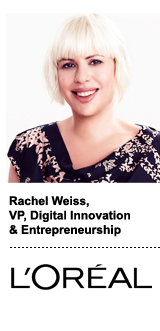 Rachel Weiss, L’Oréal USA’s VP of innovation and entrepreneurship, has some advice for any startup that comes a knocking: If you can’t share results, the deal’s off.
Rachel Weiss, L’Oréal USA’s VP of innovation and entrepreneurship, has some advice for any startup that comes a knocking: If you can’t share results, the deal’s off.
“We’ve had so many great pilots I’ve believed in, but then I had to pull my hair out to figure out whether it worked or not,” Weiss said at the M1 Summit hosted by Eniac Ventures on Tuesday in New York City.
Sometimes it just feels like all some startups care about is getting to brag that they’ve done work with a big brand, but many don’t know how to package results in a way that’s helpful or valuable for their brand partners.
“The end game is not just to say, ‘We have this partnership,’” Weiss said.
Weiss is in charge of vetting and testing new technology for L’Oréal and helping craft the brand’s digital strategy, so she’s accustomed to working outside of what might be considered the more traditional marketing KPIs. But she does need some sort of success metric, whatever it is.
“I only have so much bandwidth and budget,” she said, and when she throws her weight behind a new proof of concept, “I’m putting my ass on the line – I don’t know that a lot of founders realize that.”
They also might not realize quite how many pitches Weiss has to field from companies just like theirs.
Take the influencer space. As a beauty brand, L’Oréal is particularly interested in how it can take advantage of vloggers, bloggers and social celebs. But it’s a hugely crowded space.
“I can’t tell you how many calls I get a week from some startup doing vlogger management that’s managing the same vlogger as a startup that called me up an hour before,” Weiss said.
Which is why Weiss is always looking to cut through the clutter to find the emerging technology that’s really going to keep L’Oréal relevant.
“We’re thinking about it first from a consumer standpoint – if technology makes it easier for me to shop, to find a product, to get advice as fast as possible, if it can help demystify skin care,” she said. “We want to see the marriage of technology and consumer behavior come a little closer.”
It’s why, for example, L’Oréal is experimenting with predictive analytics companies to model the characteristics of vloggers to try and figure out which ones will work best for each of the 30 different brands under its umbrella, many of which have quite different customer bases. An influencer who speaks to the Yves Saint Laurent Beauté customer won’t necessarily work for fans of Garnier or The Body Shop.
“We’re always asking ourselves what the shelf life [of an influencer] is, will they age out? Will the audience change?” Weiss said. “We know it’s driving visits, so we’re curious how it’s going to pan out over the next couple of years.”
Basically, Weiss is bullish on anything that makes sense for the beauty category, whether that’s influencers, Snapchat, AR or VR. She’s keeping her mind open.
L’Oréal already has a popular app called Makeup Genius that taps augmented reality to let users give themselves virtual makeovers. It’s been downloaded more than 16 million times in 65 countries since 2014.
Weiss said she also sees an opportunity to use virtual reality as an educational tool for stylists. L’Oréal owns more than 600 beauty stores with products aimed specifically at hair-care professionals.
L’Oréal incubates a lot of technology itself. – little-known fact: L’Oréal is actually the largest owner of nanotechnology patents – but on the digital marketing side, it needs good partners that can prove their worth.
“We need to find the right partners,” Weiss said. “Part of my job is ensuring that the things we pick and the ideas we think will drive the business forward come to life.”










